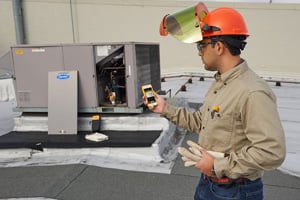
MacDonald-Miller Facility Solutions is a leading construction, engineering, control systems, and building services firm headquartered in Seattle, Washington. The company's Building Services group is the largest commercial HVAC service company in the Northwest, with offices throughout Washington and Oregon. They provide maintenance, repair, overhaul, and installation of everything from centrifugals to reciprocating refrigeration systems to electronic building control systems.
They also perform air balancing, plumbing, electrical services and panel scanning and have extensive experience with specialized applications such as clean rooms, computer rooms, research labs, and medical and testing facilities. Eric Sundby is one of the company's area operations manager for Eastern Washington and works out of the Moses Lake, Washington office. He supervises field technicians on all aspects of HVAC, including heating, cooling and associated measurements, electrical test on motors pumps, compressors, electric boilers, furnaces, and flame signals and much more.
The facilities cover pretty much everything commercial from retail strip malls to light commercial structures, to high-rises to biotech facilities, including hospitals, medical facilities, data centers and clean rooms used in research and development. They also work on cell sites, cell towers, switch stations, and telecommunication hubs.
Standardizing on a workhorse meter
MacDonald-Miller standardized on the Fluke 902 Clamp Meter when it came out several years ago. Technicians used it for daily maintenance work involving voltage, current and temperature readings. When the new Fluke 902 FC Wireless Clamp Meter came out they started replacing the previous model with the new Fluke Connect model. “For the day-to-day stuff the Fluke 902 FC is pretty much our workhorse,” says Sundby.
In addition to the wireless capabilities that allow technicians to connect the meter to the equipment and then step back out of the blast zone and read the measurements on their smart phones, Sundby is especially pleased with the new resistance measurements to 60 kΩ. “With the previous model, if you needed to read sensors that were above 6,000 ohms, you would have to use a different meter,” says Sundby. “When you're working on a roof you don't want to have to carry extra tools and you really don't want to have to run back to your truck and get another meter.”
MacDonald-Miller also likes that the wireless 902 FC offers the same rugged utility and reliability as the previous model, so it handles the day-to-day banging around common to field maintenance. While not the deciding factor, cost was important as well, considering the number of meters involved. “The cost for the new 902FC didn't change much from our old 902 so cost wasn't really an issue,” says Sundby.
All in a day's work
While there's really no such thing as a typical day for a McDonald-Miller crew there are some common denominators. For a typical job with rotating equipment a technician would use the 902 FC to run voltage and current tests, and phase imbalances in both voltage and current. Moving on to the rest of the HVAC system the technician would measure temperatures on pressure, suction, discharge, and liquid refrigerant lines.
“We do Delta T's across the evaporator coils and across the condenser coils, and we check suction, discharge, and liquid temperatures,” Sundby explains. “We use the 902 FC for that, too, because they just switch a lead and they can change to temperature, connect their surface probes, and off they go.”
In addition to the 902 FC, MacDonald-Miller technicians carry a Fluke 116 digital multimeter or a Fluke 87V when they need to take higher level readings. Some building performance and electrical technicians also carry Fluke a thermal imager. Chiller technicians may carry a Fluke 1520 insulation tester to check for pinhole leaks in windings and other damage.
Good work takes training
Maintenance work on commercial and industrial HVAC equipment is not a trivial task, and making sure the people who do it are up to the task involves more than just providing them with the proper test instruments. Most newly-hired technicians are graduates of a two-year associate's degree program at a community college or tech school, Sundby explains. When they're hired by MacDonald-Miller or another union contractor they enter a union apprenticeship program that lasts for four years—or five, for those who don't have that associate's degree. And even after six years the training doesn't stop. The company maintains a large training facility in Seattle. “We put on three-hour classes twice a week.” says Sundby. “The guys come in at night to learn about new products and testing and programming, whatever it happens to be, from refrigeration to safety,” says Sundby. “Suppliers also conduct classes on everything from meters to variable frequency drives.”
Summary
MacDonald-Miller's servicing operation handles a wide variety of tasks on different types of equipment. By standardizing on just a few Fluke instruments and by providing its people with strong training and support, the company has been able to increase the effectiveness of its operations and cut costs at the same time. All in all, it's a win-win situation.
Growing green facilities
MacDonald-Miller has another, greener arm of the business. Led by Perry England, the sustainable, eco-friendly Building Performance group helps customers plan, build, retrofit, and maintain building environmental systems for maximum efficiency and reliability. Following LEED, Green Globes, Lean Design, and other practices, the group has built a uniquely integrated understanding of green building automation technologies. Some classic reliability practices, such as preventive maintenance and equipment modernization, transfer over. What's different is the layer of documentation and highly networked tools for data analysis and trending. England says the change makes good business sense. Customers are demanding green building efficiency and changes in financial lending models increasingly support it.